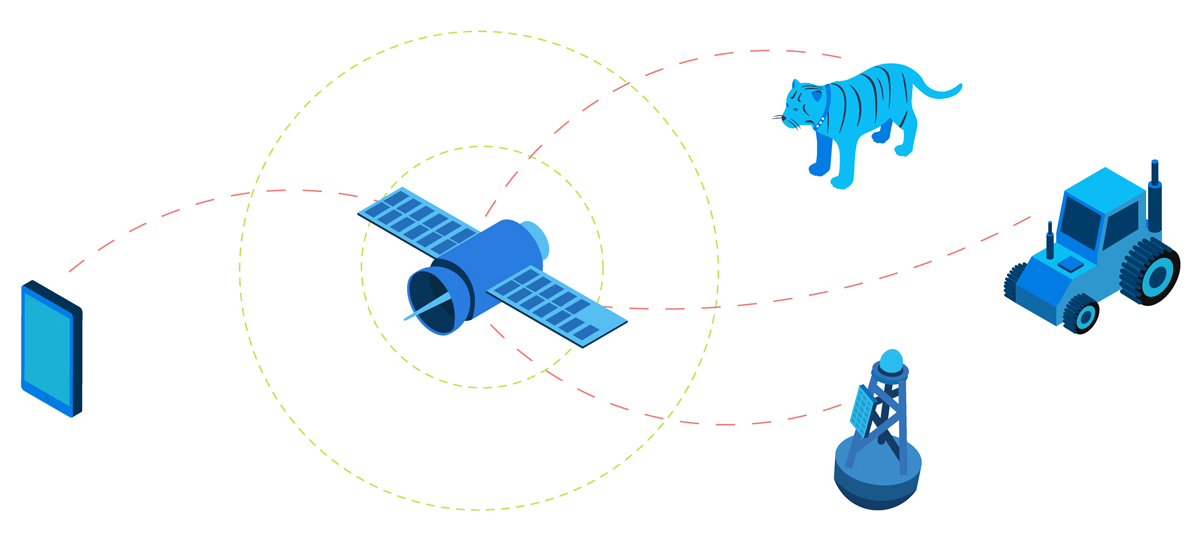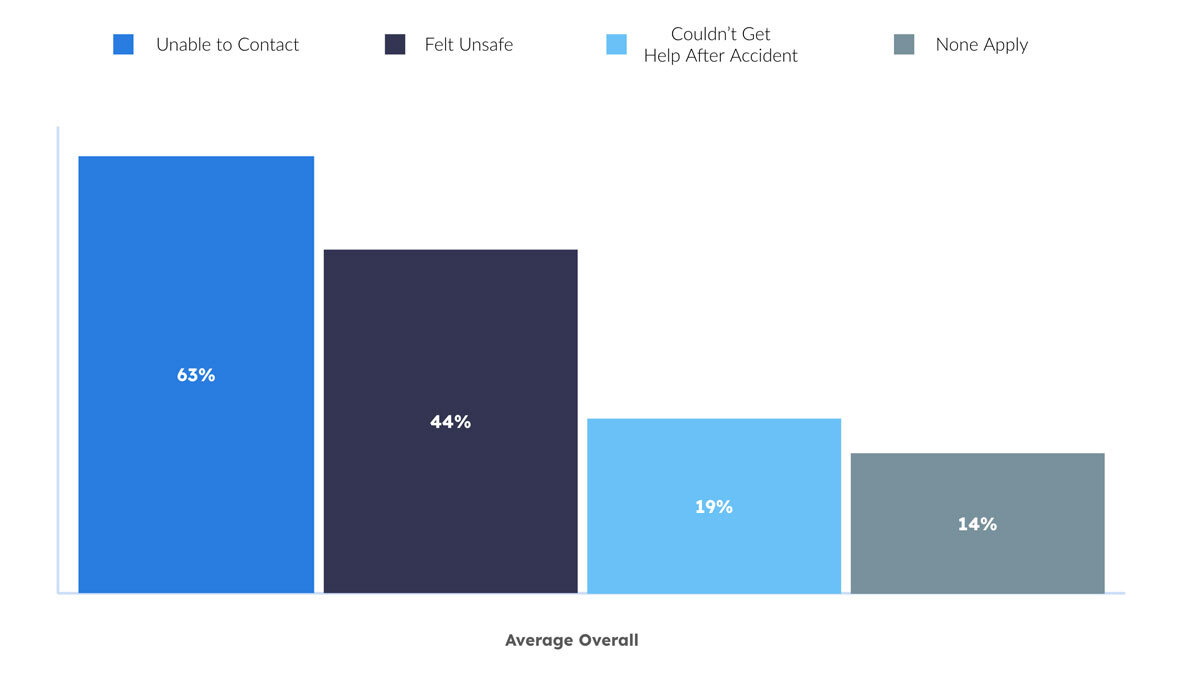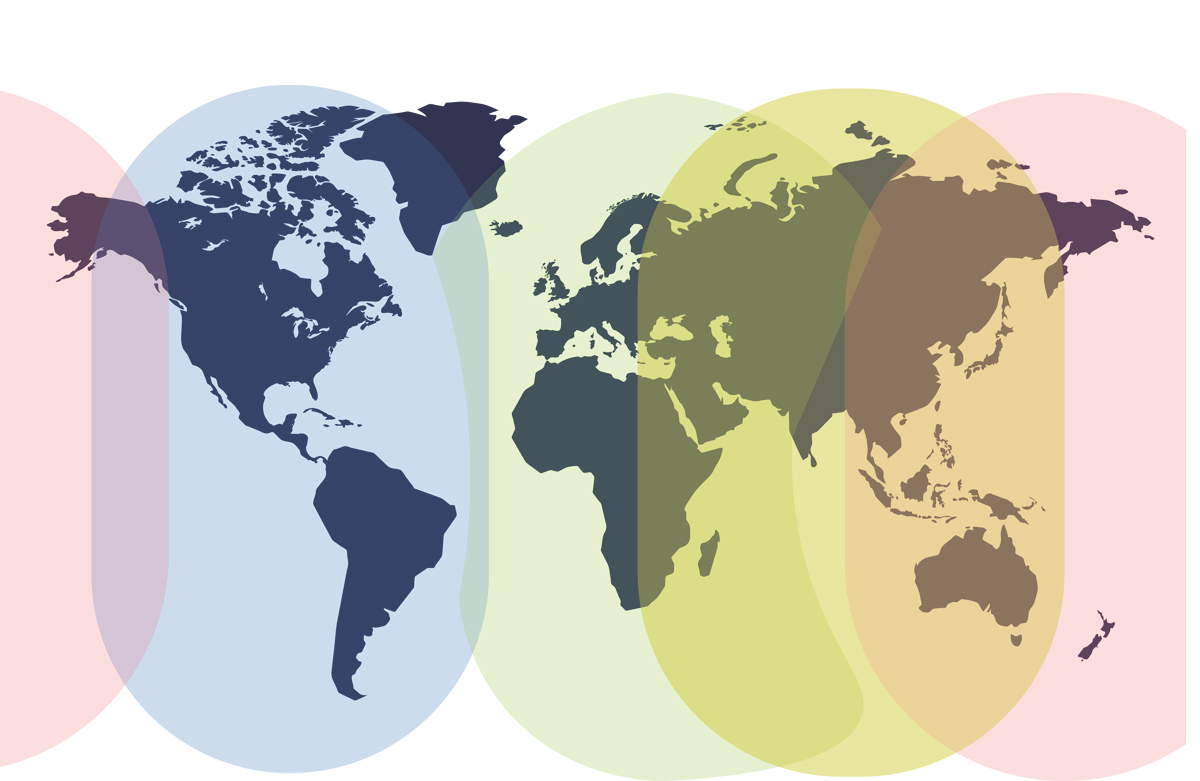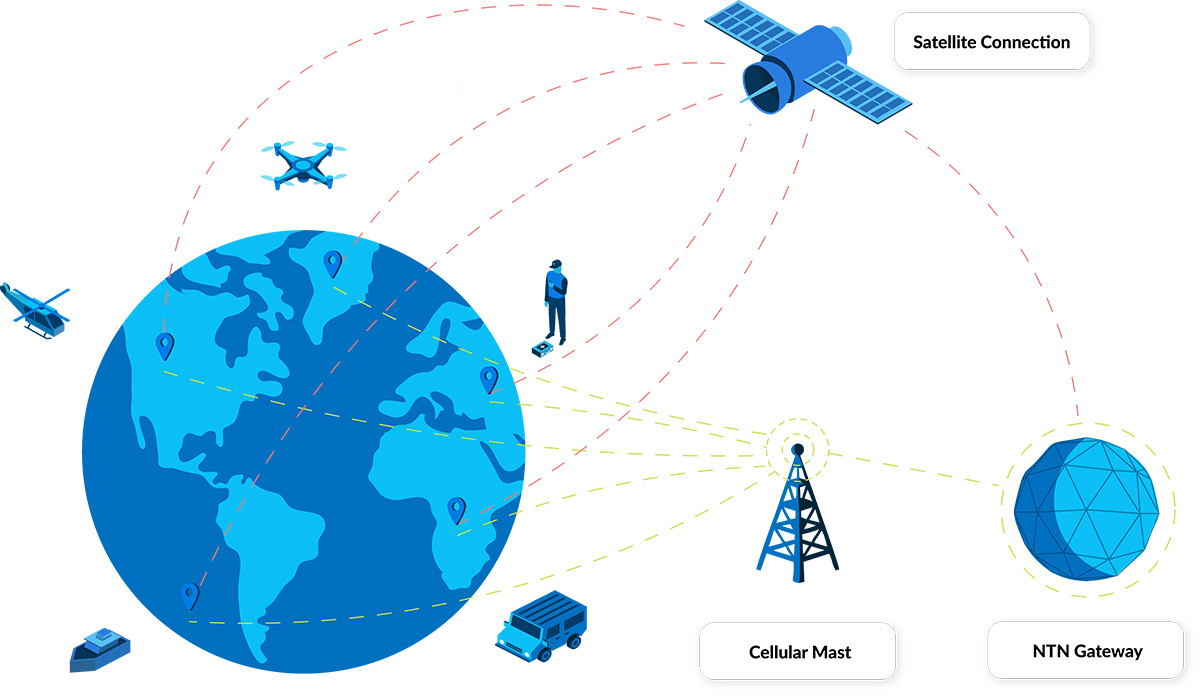Direct-to-Direct (D2D) satellite connectivity is one of the most talked about innovations in IoT right now. It promises seamless global coverage, allowing connected devices, from smartphones to smart sensors, to communicate with satellites without the need for additional hardware such as a specialized antenna.
At first glance, D2D sounds like the ultimate solution for remote IoT applications. But there’s a problem: the term is being used too broadly and too optimistically. Many assume that D2D is synonymous with standards-based satellite IoT, like NTN NB-IoT or LTE Cat-1 over satellite. In reality, these are adjacent but distinct technologies, each with very different capabilities, timelines, and trade-offs.
In this post we’ll cut through the noise to discover what’s actually available today, and what will be available in six months, one year, and beyond. We’ll look at the benefits and limitations of D2D, and explore whether you would be better off focusing on standards-based satellite IoT as you consider what’s best for your IoT deployment.
What Direct-to-Device (D2D) Actually Means
Direct-to-Device (D2D) connectivity means that a device – typically a smartphone – can communicate directly with a satellite (part of a non-terrestrial network, or NTN) without requiring additional external hardware like a specialized antenna / dongle.
D2D is a capability, not a standard. It means a device can talk directly to a satellite, but that doesn’t necessarily mean it uses NB-IoT or LTE.
The most well-known example is Apple’s agreement with Globalstar. Newer iPhones embed chipsets that allow them to access the Globalstar satellite constellation where available. This is a proprietary technology, meaning iPhones cannot connect to other satellite networks.
While still relevant, the Globalstar/Apple partnership is an outlier. Today, D2D is often referenced in the context of standards-based connectivity – but that’s where definitions start to blur.
D2D and Standards-Based Connectivity: Not the Same Thing!
Standards-based NTN connectivity refers to satellite networks that adhere to existing cellular standards, e.g. NB-IoT and LTE Cat 1.
A key benefit of this is that you don’t have to modify your data to send it through a proprietary satellite protocol. Standards-based connectivity also opens the door to switching networks for broader coverage or better pricing – a flexibility not available with proprietary solutions.
But here’s the key distinction:
D2D
Standards-Based NTN
D2D is about the physical capability for a device (e.g., smartphone or sensor) to connect to a satellite without extra hardware.
Standards-based is about ensuring that the satellite connection adheres to existing cellular protocols like NB-IoT and LTE Cat 1.
The connection can be proprietary or standards-based.
Compatible devices may still require separate hardware to connect, especially today.
Pure D2D for IoT is limited today and requires ideal antenna positioning and sky visibility.
You can access standards-based NTN today, usually via an external transceiver / dongle.
What’s Available Now (Early 2025)?
There are two cellular standards being adopted by satellite network operators: NB-IoT and LTE Cat 1.
- NB-IoT uses very little bandwidth and is being rolled out by providers like Iridium and Viasat to complement their proprietary solutions.
- LTE Cat 1 requires more bandwidth and is being pursued by newer entrants like Starlink and AST SpaceMobile, who partner with mobile network operators (MNOs) to access spectrum.
The standard closer to delivery is NTN NB-IoT. Skylo is not a satellite network operator, but has done a lot of work to make NB-IoT work over existing satellite networks. They have partnered with multiple satellite networks, including Viasat and Ligado Networks, to bring a solution to market in the USA, Canada, Australia, New Zealand and Brazil.
Some satellite network operators are already offering this service in a limited capacity – Sateliot were among the first to market with a proposition. However, they’re in the process of scaling their satellite IoT services; initial store-and-forward services are available, but fully operational coverage will be c. 2028.
At the moment, the hardware being built for IoT tends to take the form of a unit that can be attached to a sensor or gateway to facilitate NTN connectivity.
Why is Separate Hardware Still Needed for IoT?
- Many sensors or gateways don’t yet support NTN NB-IoT or LTE Cat 1 and will need to pass data through a connected device which can re-format the data to work with the appropriate standard.
- Satellite connectivity requires a clear view of the sky. Devices embedded in machinery or under panels (like an OBDII port or solar-powered sensor) are unlikely to maintain a reliable satellite link.
What Will Be Available In Six Months (Mid-Late 2025)?
In terms of NB-IoT, Viasat’s “IoT Direct” is currently in beta mode, before a full release in the second half of 2025. This will deliver global NB-IoT capabilities for connected devices, and we’re particularly excited about this development.
We also expect the first LTE Cat 1 service for IoT from Starlink to be available before the end of 2025. Starlink’s “D2C” model depends on cooperation from mobile network operators, and rollout will begin in countries with large land masses and low population density, where unused spectrum is more available.
Current rollout countries are the USA, Canada, Australia, New Zealand, Chile, Peru, Ukraine, Switzerland, and Japan.
What Will Be Available in One Year?
We should see more integrated, true D2D devices that can connect to both cellular and satellite networks using standard protocols, without needing separate antennas. But these are unlikely to be materially lower cost than the current, proprietary options available. This is because it is both economies of scale and competition that drives prices down, and that will take a little longer to come to fruition.
Starlink will likely have its first competitor in the LTE space (no pun intended) with the commercial launch of AST SpaceMobile anticipated in early 2026. However, AST SpaceMobile is focused squarely on the cellphone market rather than IoT devices; it will probably be another 12 months (early 2027) before IoT devices can connect to the AST SpaceMobile network. It’s also worth mentioning that AST SpaceMobile also needs agreements with MNOs to deliver its service; it will not be global at launch.
The Future (2-5 Years)
The update that allowed cellular standards to be used over satellite is called 3GPP Release 17. While Rel-17 made it possible to use cellular standards in satellite communication, it didn’t make it easy, with companies like Skylo having to do a considerable amount of engineering to make NB-IoT transmissions over satellite a reality.
Iridium, currently the world’s only global satellite IoT network, was a little late to the party in developing a standards-based proposition, but now that it is, it’s working very closely with the 3GPP to extend the functionality of NTN NB-IoT. This collaboration means that 3GPP Release 19 (anticipated in late 2025) will remove many technical challenges and hasten the widespread availability of industry standard chipsets.

*3GPP compliant release 10 or newer, modem must support existing bands of operation in intended service countries
We also anticipate that we’ll see increased data throughput, greater power efficiency, and lower latency as these advanced protocols coupled with new satellite modems filter through, enabling smaller, lower cost and longer lasting IoT devices.
The reason this falls into the 2-5 years section is because the benefits take several years to reach end users. Firstly, network operators, device manufacturers and other industry stakeholders will need time to implement the new standards, which can involve significant hardware and software updates, plus extensive testing.
Deployment of the new technology across networks is often piecemeal, too, rolled out across regions and service providers at different times – meaning that it will take time to become widely available. And, of course, end users’ devices must be compatible with the new standards; this will include firmware changes to support the lower speeds and smaller message sizes available over NTN NB-IoT.
While NB-IoT remains the most popular choice for delivering NTN standards-based connectivity, by this time we’d anticipate also having IoT propositions from AST SpaceMobile and Lynk using the LTE Cat 1 standard. These new satellite network operators, along with Starlink, will undoubtedly create more commercial agreements with mobile network operators, extending the reach of NTN LTE Cat 1 services.
What Should IoT Businesses Do Now?
It depends on the criticality and data requirements of your application. While NTN NB-IoT services are reaching the market, the throughput is very small, and data transmission is infrequent, so it best serves applications where there are a high number of end points, but real-time information is not required (e.g., livestock tracking, environmental monitoring, agriculture, basic fleet management, and wearables).
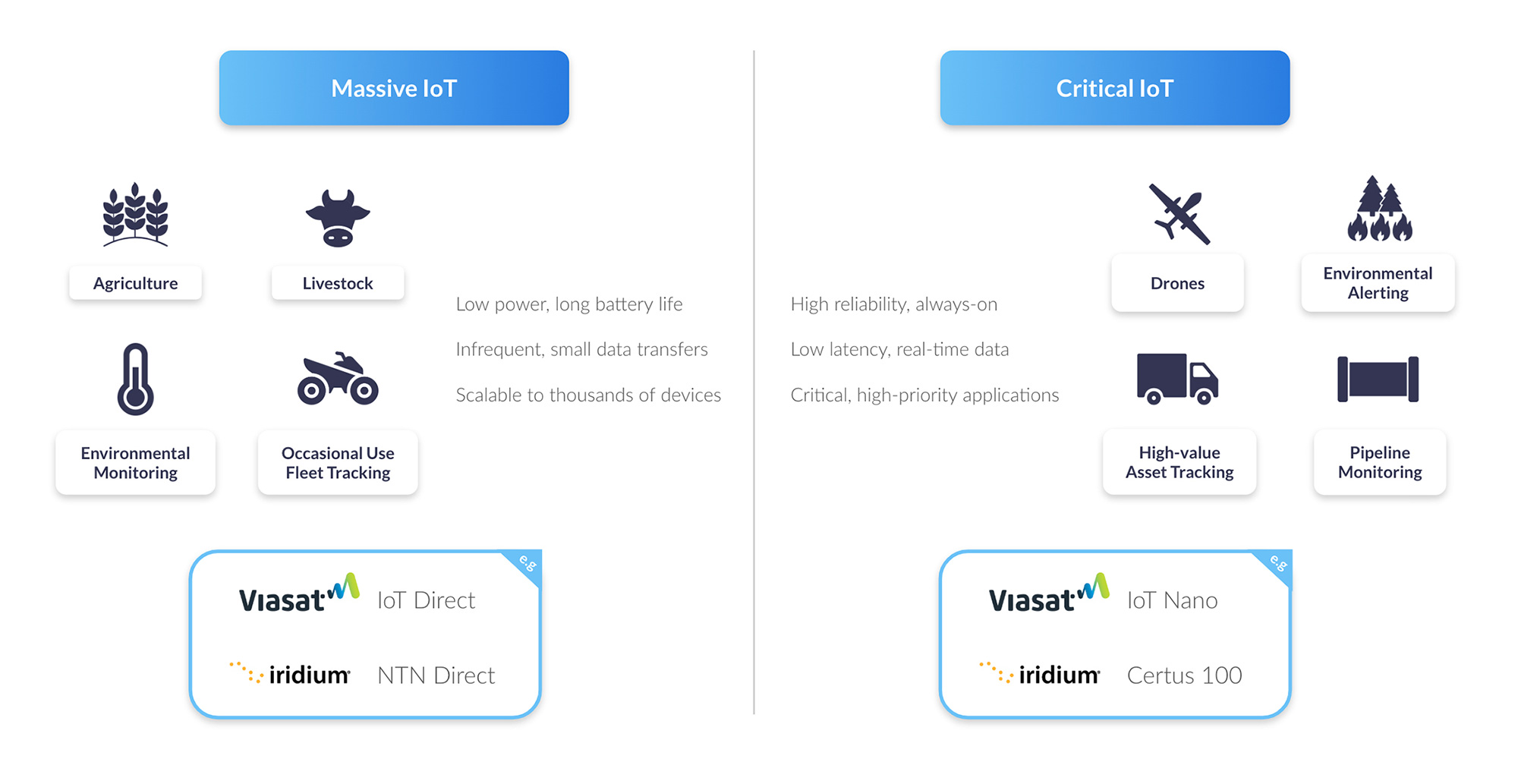
If this describes your application, get in touch with a service provider like Ground Control to get advice on the best network and hardware for your application. Note that this will almost certainly involve additional hardware, as the satellite industry is some way from solving the issues around device compatibility and antenna siting mentioned earlier.
If you need higher volumes of data and closer to real-time data, you will still be better served by a proprietary solution such as IMT / Certus 100 from Iridium, or IoT Nano from Viasat. These services are well established and globally available; they will co-exist alongside the standards-based solutions for the foreseeable future.
Finally, don’t get too preoccupied with D2D; it offers exciting possibilities, but it’s still a developing technology that won’t be widely available for some time, and will only be appropriate for certain use cases.
Ready to explore your options?
If you’re exploring how to keep your IoT devices connected beyond the reach of terrestrial networks, we’re here to help. At Ground Control, we work across both proprietary and standards-based satellite networks to recommend the best-fit solution for your use case – today, and in the future.
Whether you’re ready to deploy now or just starting to assess the landscape, we’d love to talk. Get in touch for practical, honest advice on devices, networks, and everything in between. Email hello@groundcontrol.com or complete the form, and we’ll be in touch within one working day.

